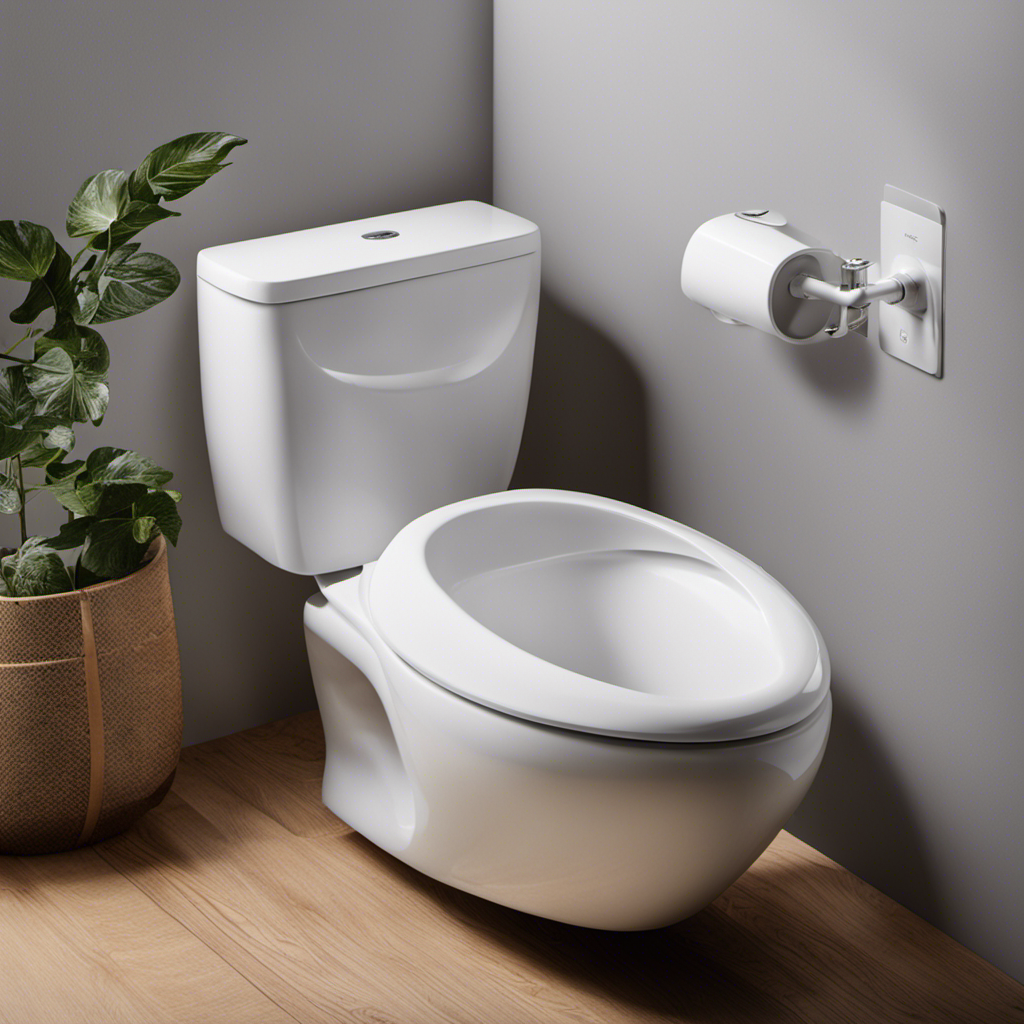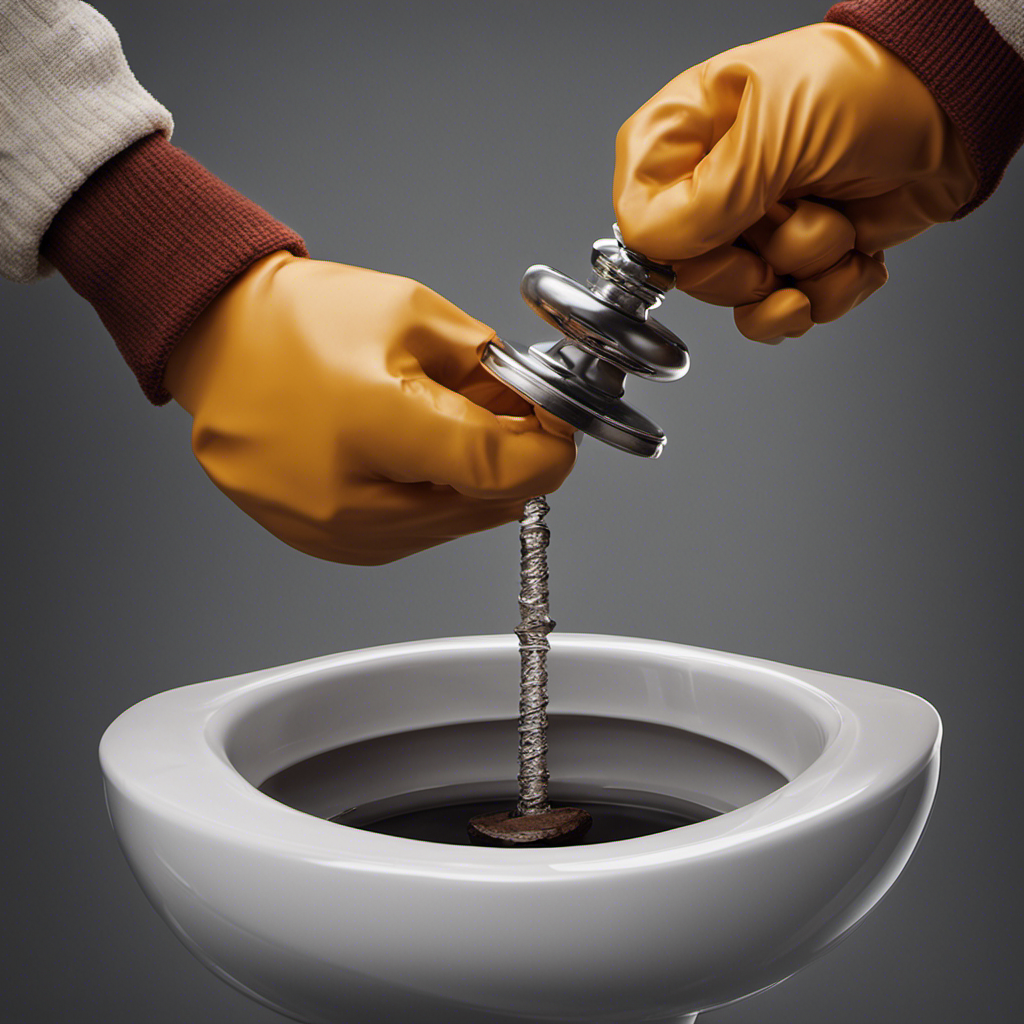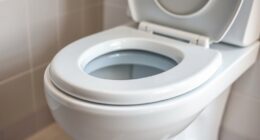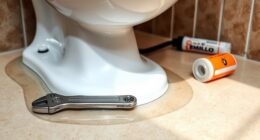Do you find yourself wondering why your toilet seems to have a mind of its own? If your toilet has a tendency to ‘run’ more often than it should, don’t worry – you’re not alone.
In this article, we will delve into the common causes of a running toilet and provide you with practical solutions to fix the issue. From faulty flapper valves to problematic water fill valves, we’ll tackle it all.
So sit back, relax, and let’s get to the bottom of why your toilet won’t stop running.
Key Takeaways
- Faulty flapper valve is a common cause of a running toilet.
- Regular maintenance and timely replacement of the flapper valve are important to prevent water leakage.
- Adjusting the water fill valve can help fix a running toilet.
- High and low water pressure can affect the proper functioning of a toilet.
Common Causes of a Running Toilet
One common cause of your toilet running is a faulty flapper. The flapper is a rubber valve located at the bottom of the toilet tank, which controls the flow of water from the tank into the toilet bowl.
When the flapper becomes worn out or malfunctions, it may not fully seal the opening, causing water to continuously leak from the tank into the bowl. This constant flow of water leads to a running toilet.
It is important to address this issue promptly, as a running toilet can waste a significant amount of water and increase your water bill.
Now that you understand the common cause of a running toilet, let’s explore how a faulty flapper valve causes this problem.
How a Faulty Flapper Valve Causes a Running Toilet
A faulty flapper valve can cause a running toilet. When the flapper valve is not functioning properly, water continuously leaks from the tank into the bowl, causing the toilet to run. To ensure proper functioning and prevent a running toilet, it is important to perform regular flapper valve maintenance.
Here are three signs of a faulty flapper valve:
-
Constantly running water: If you hear the sound of water running in your toilet even when it is not being used, it is likely due to a faulty flapper valve.
-
Slow tank refill: If it takes a long time for the tank to refill after flushing, it may be a sign that the flapper valve is not closing properly, causing water to continuously leak.
-
Water leaks into the bowl: If you notice water leaking into the bowl from the tank, it indicates that the flapper valve is not sealing tightly, leading to a running toilet.
Regular maintenance and timely replacement of a faulty flapper valve can help prevent a running toilet and conserve water.
Fixing a Water Fill Valve to Stop a Running Toilet
To fix a water fill valve and stop your running toilet, you should first turn off the water supply to the toilet. This will prevent any water from flowing while you work on the valve.
Once the water supply is off, locate the water fill valve, which is usually located on the left side of the toilet tank. Check for any signs of damage or wear, such as leaks or cracks. If the valve looks fine, you may just need to adjust it.
To do this, turn the adjustment screw clockwise to decrease the water level, or counterclockwise to increase it. Make small adjustments until the water level is at the desired height.
Remember to turn the water supply back on and test the toilet to ensure it no longer runs.
Regular water fill valve maintenance and adjustment can help prevent future running toilet issues.
Addressing a Faulty Float System in a Running Toilet
You can fix a faulty float system in your running toilet by checking if the float is properly adjusted and not sticking. To troubleshoot float issues and address the problem effectively, follow these steps:
-
Check the float height: Ensure that the float is positioned at the correct height. If it is too low, it may not trigger the fill valve to shut off, causing the toilet to continuously run. Adjust the float by bending the float arm or adjusting the float screw.
-
Inspect for sticking: Sometimes, the float can get stuck, preventing it from rising and shutting off the fill valve. Check for any debris or obstructions that may be causing the float to stick. Clean the float and its mechanism thoroughly to ensure smooth operation.
-
Replace the float: If adjusting the float height and cleaning it doesn’t resolve the issue, it may be necessary to replace the float altogether. Floats can wear out over time, leading to malfunction. Purchase a new float from a hardware store and follow the manufacturer’s instructions to install it correctly.
Troubleshooting a Running Toilet Due to a Faulty Flush Handle
If you find that your toilet handle feels loose when you go to flush, there may be a simple fix to get it working properly again.
A loose flush handle can be caused by a variety of issues, such as a loose mounting nut or a worn-out handle mechanism.
Another common problem is a bent or broken handle, which can prevent the toilet from flushing properly.
In some cases, the handle may be beyond repair and will need to be replaced entirely.
Loose Flush Handle
The flush handle’s loose and causing your toilet to run. A loose handle is a common issue that can lead to a constantly running toilet. Here are some troubleshooting steps and handle repair options to fix the problem:
-
Tighten the handle: Start by checking if the handle is securely attached to the toilet tank. If it’s loose, use a screwdriver or wrench to tighten the mounting nut.
-
Replace the handle: If tightening doesn’t solve the problem, the handle may be worn out or damaged. Purchase a new handle from a hardware store and follow the manufacturer’s instructions to install it.
-
Call a plumber: If the handle is still loose after attempting the above steps, there may be a more significant issue with the toilet’s internal mechanisms. It’s best to seek professional help to diagnose and fix the problem.
Bent or Broken Handle
When a flush handle is bent or broken, it can prevent proper flushing of the toilet. This can be a frustrating issue to deal with, but luckily, there are ways to repair a bent handle and ensure your toilet functions smoothly once again. Here are some handle maintenance tips to help you fix the problem:
| Maintenance Tips |
|---|
| Inspect the handle for any visible signs of damage |
| Use pliers to straighten a bent handle |
| Replace a broken handle with a new one |
Need for Handle Replacement
Replacing a broken handle is necessary to ensure proper flushing of the toilet. If your toilet handle is broken or not functioning correctly, it can lead to a variety of issues, such as a constantly running toilet or difficulty flushing.
To address this problem, here are three handle replacement options to consider:
-
Identify the type of toilet handle you have: There are two common types of handles – the lift arm and the trip lever. Understanding which type you have will help you choose the correct replacement.
-
Purchase a replacement handle: Visit a local home improvement store or shop online for a compatible replacement handle. Make sure to check the dimensions and compatibility with your toilet model.
-
Install the new handle: Follow the manufacturer’s instructions to remove the broken handle and install the new one. This may involve removing the tank lid, loosening a nut, and attaching the new handle.
Regular handle maintenance and timely replacement can help ensure smooth and efficient flushing of your toilet.
Understanding the Role of Water Pressure in a Running Toilet
To understand why your toilet runs, you should check if the water pressure is too high. Water pressure plays a crucial role in the functionality of your toilet. When the pressure is too high, it can cause the toilet to continuously run, wasting water and leading to higher utility bills. High water pressure can result in a faulty fill valve or a damaged flapper, causing water to continuously flow into the toilet bowl. On the other hand, low water pressure can also lead to a running toilet, as the fill valve may not be able to properly close. Troubleshooting the water pressure can help you identify and fix the issue. Here is a table outlining the effects of water pressure and some troubleshooting tips:
| Effects of High Water Pressure | Effects of Low Water Pressure | Troubleshooting Tips |
|---|---|---|
| Continuous running toilet | Inadequate flushing | Check water pressure regulator |
| Leaking or dripping faucets | Slow-filling toilet tank | Inspect fill valve and flapper |
| Damaged appliances and pipes | Reduced water flow in faucets and showers | Check for clogs in water supply lines |
| Increased risk of pipe bursts | Reduced water pressure in appliances | Consult a professional plumber |
Conclusion
So there you have it! Now you know why your toilet runs and how to fix it.
It’s important to address common issues like a faulty flapper valve, water fill valve, float system, or flush handle to prevent water wastage and keep your toilet functioning properly.
Remember, a running toilet can not only be annoying, but it can also increase your water bill. So don’t delay, use these practical tips to put a stop to your toilet troubles and save some cash.
Happy flushing!










